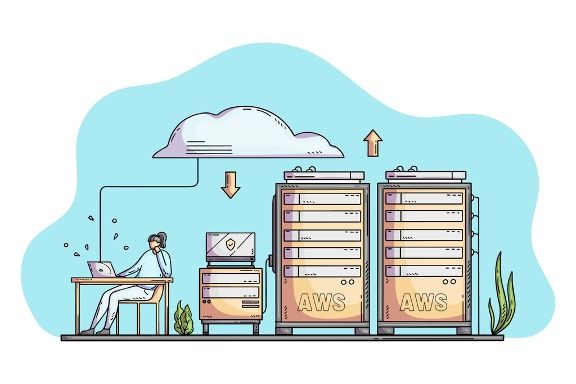From Legacy to Cloud - The Top Strategies for Successful Database Migration to AWS

As more businesses start using cloud computing, many of them will need to move their databases. Businesses must move away from their old systems and onto cloud-based platforms if they want to stay competitive, efficient, and safe.
In this article, we'll talk about the best ways to move a database to Amazon Web Services (AWS). We'll look at the benefits of moving to the cloud, how to assess and evaluate database migration, the tools available for database migration, and how to change application code to work with the new database engine. We'll also talk about how important it is to test applications and their performance, and we'll end by looking at the future of moving databases to the cloud.
Benefits of migrating to the cloud
Putting your database in the cloud has a number of advantages that can help your business stay competitive and flexible.
- Cloud computing provides scalability in terms of storage and computing power. As your business grows, you can easily scale up or down your database resources to meet your needs without worrying about hardware limitations.
- Cloud computing offers improved security for your database. AWS provides various security features, such as firewall protection, encryption, and access control, that can help protect your database from cyber threats.
- Moving to the cloud can help cut down on the costs of managing and maintaining hardware that is kept on-site. With cloud computing, you pay only for the resources you use, and you can easily adjust your usage to meet your needs. This eliminates the need for costly hardware purchases and maintenance.
Database Migration Assessment
It is important to do a database migration assessment before moving your database to AWS. This process involves taking a look at your current database environment and figuring out which databases should be moved and what data should be moved.
The assessment process includes finding the databases that need to be moved, figuring out their size, complexity, and usage, and figuring out the risks and limits of the move. For a successful migration, it is important to include the right people in the assessment process.
Database Migration Evaluation
After conducting the migration assessment, the next step is to evaluate the migration strategy. This involves selecting the migration approach, the migration tools, and the migration timeline. AWS provides several migration strategies, including lift and shift, database migration service, and hybrid migration.
In the process of evaluating migration, you also have to choose the database migration service that fits your needs best. AWS has two main migration services: AWS Database Migration Service (DMS) and AWS Schema Conversion Tool (SCT).
Tools for database migration to AWS - AWS DMS and AWS SCT
AWS Database Migration Service (DMS) is an easy way to move your databases to AWS. It is a fully managed service. It supports both homogeneous and heterogeneous migrations, and it can migrate data from various sources, including Oracle, SQL Server, MySQL, and PostgreSQL, to AWS.
AWS Schema Conversion Tool (SCT) is a tool that helps you convert your database schema from a specific database engine to another (like from Microsoft SQL Server to PostgreSQL). It lets you change the format of schema objects like tables, views, and stored procedures to the format of the target engine. SCT also gives advice on how to convert database code, which is important to make sure that your applications work correctly after migration.
Migrating schema objects with AWS Schema Conversion Tool
The first step in migrating from one database engine to another is to convert the schema objects. Migrating schema objects with the AWS Schema Conversion Tool (SCT) involves several steps.
- Install and configure the Schema Conversion Tool and connect it to your source database.
- Create an AWS schema in the target database and map the schema objects from the source database to the target database.
- Use the schema conversion feature to change the schema objects to the format of the target database.
- Apply the converted schema objects to the target database.
Migrating data with AWS Database Migration Service
After the schema objects are migrated, you can start migrating the data using the Database Migration Service (DMS).
Migrating data with AWS Database Migration Service involves several steps.
- Create an AWS DMS replication instance and configure the replication settings.
- Create a source endpoint and a target endpoint, and configure the connection settings.
- Create a migration task and select the source and target endpoints. Fourthly, you need to start the migration task, monitor the progress, and troubleshoot any issues that arise.
- Check the results of the migration and make sure that the data in the source database and the target database are the same.
Application code conversion to the new database engine
Converting the code for your applications is a necessary step to make sure they work correctly after you move them to AWS. It means changing your application code to the format of the new database engine and making sure that the queries and commands for the database are compatible with the new database.
As mentioned before, the AWS SCT can help with converting your application code. However, some manual changes may be needed, and sometimes these can be very complex and time consuming. Ensuring you understand your application code and application logic is critical to successfully migrating the code.
Application and performance testing
After converting your application code and moving your data, you need to do application and performance testing to make sure that your applications work correctly and perform at their best. You can use AWS's monitoring and observability tools, like Amazon CloudWatch and AWS X-Ray, to keep an eye on your apps and find problems if they happen.
It is also important to include application developers and end users in the testing process to make sure the apps meet their needs.
Conclusion - The future of database migration to the cloud
When you move your database to AWS, you can save money, make it easier to use, and make it scalable. To make sure the migration goes well, you need to assess and evaluate the database migration, choose the right migration tools, and change your application code to work with the new database engine.
After moving your database, it's important to test your applications and their performance to make sure they work correctly and run at their best. AWS has a number of tools and services, like AWS DMS and SCT, that can help you move your database quickly and easily.
Migration of databases to the cloud seems to have a bright future, as more companies use cloud computing to stay competitive and efficient. As technology changes, AWS will keep coming up with new solutions and services that can help companies move their databases to the cloud without any problems.
If you want to move your database to AWS, we suggest you do a database migration assessment and evaluation, choose the right migration tools, and get your application developers and end users involved. AWS has a number of tools and services, like AWS DMS and SCT, that can help you move your database without any problems.
